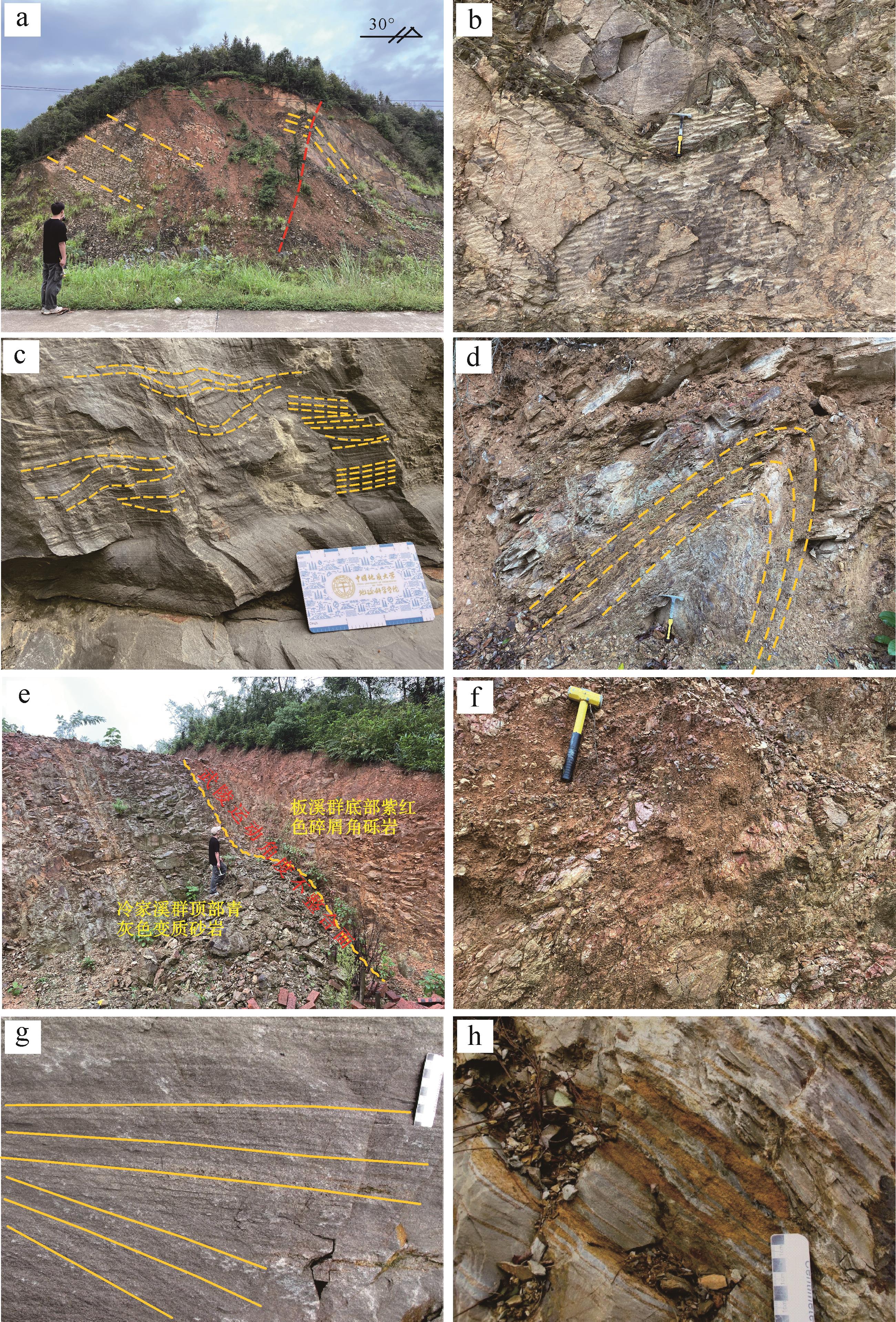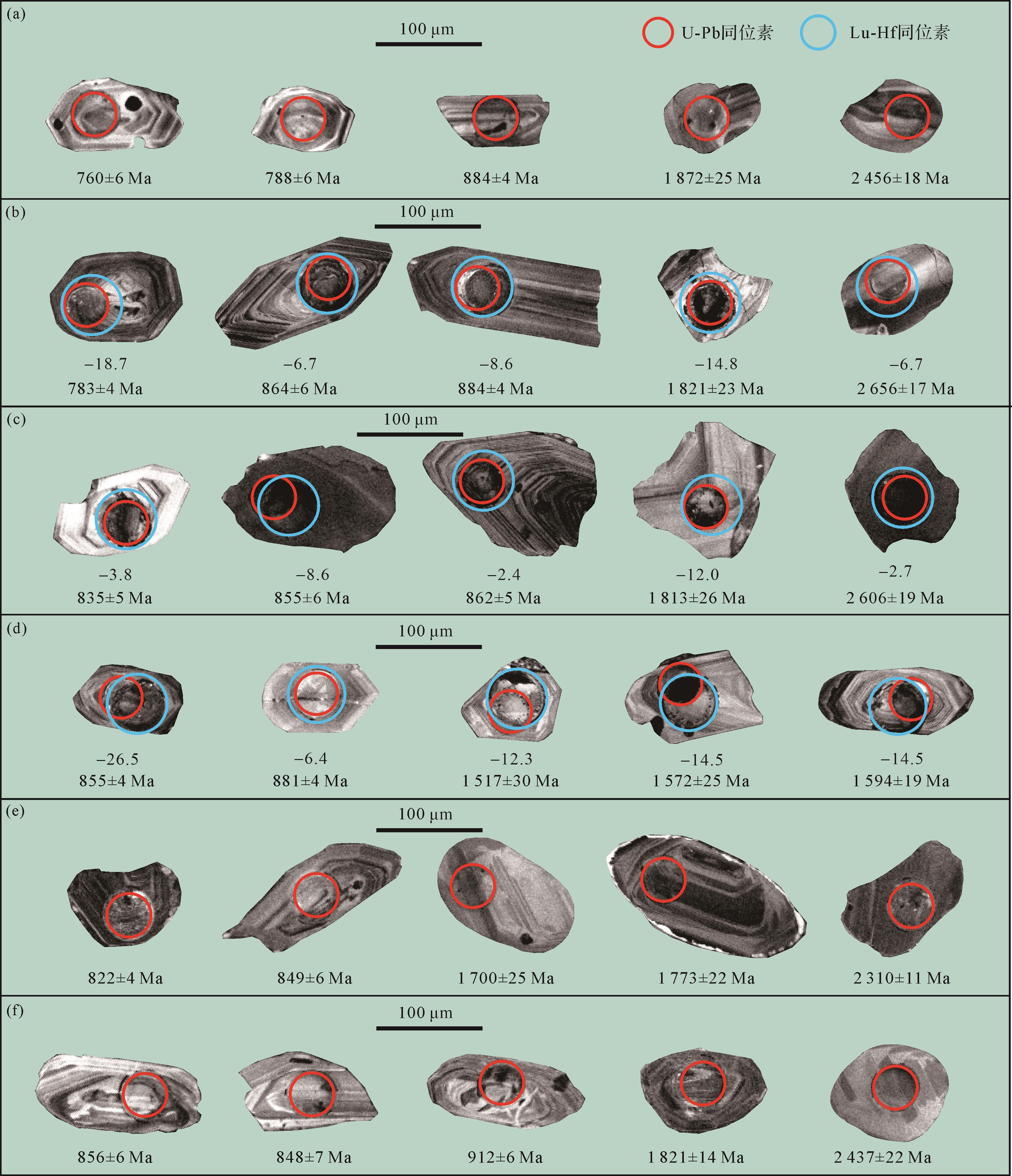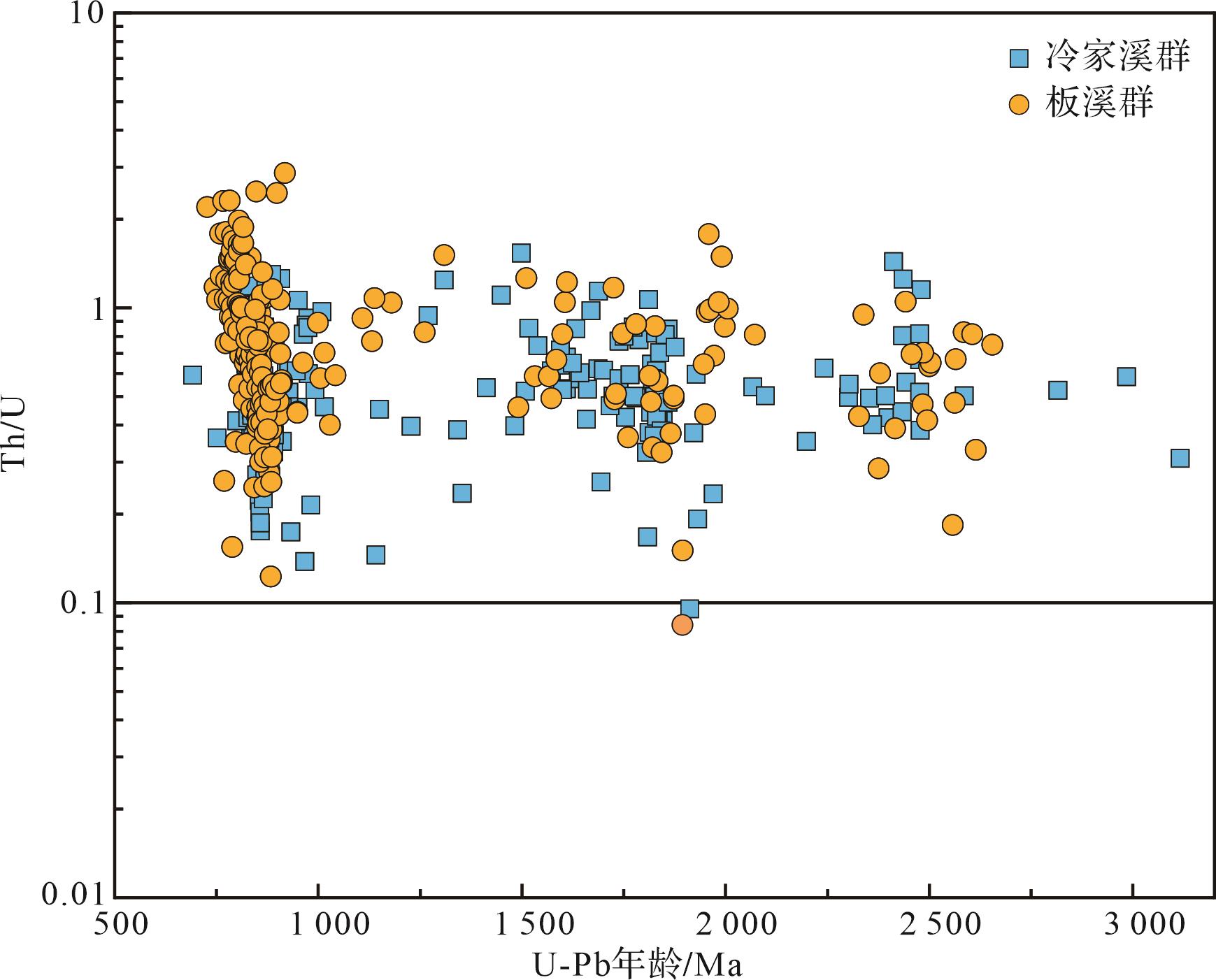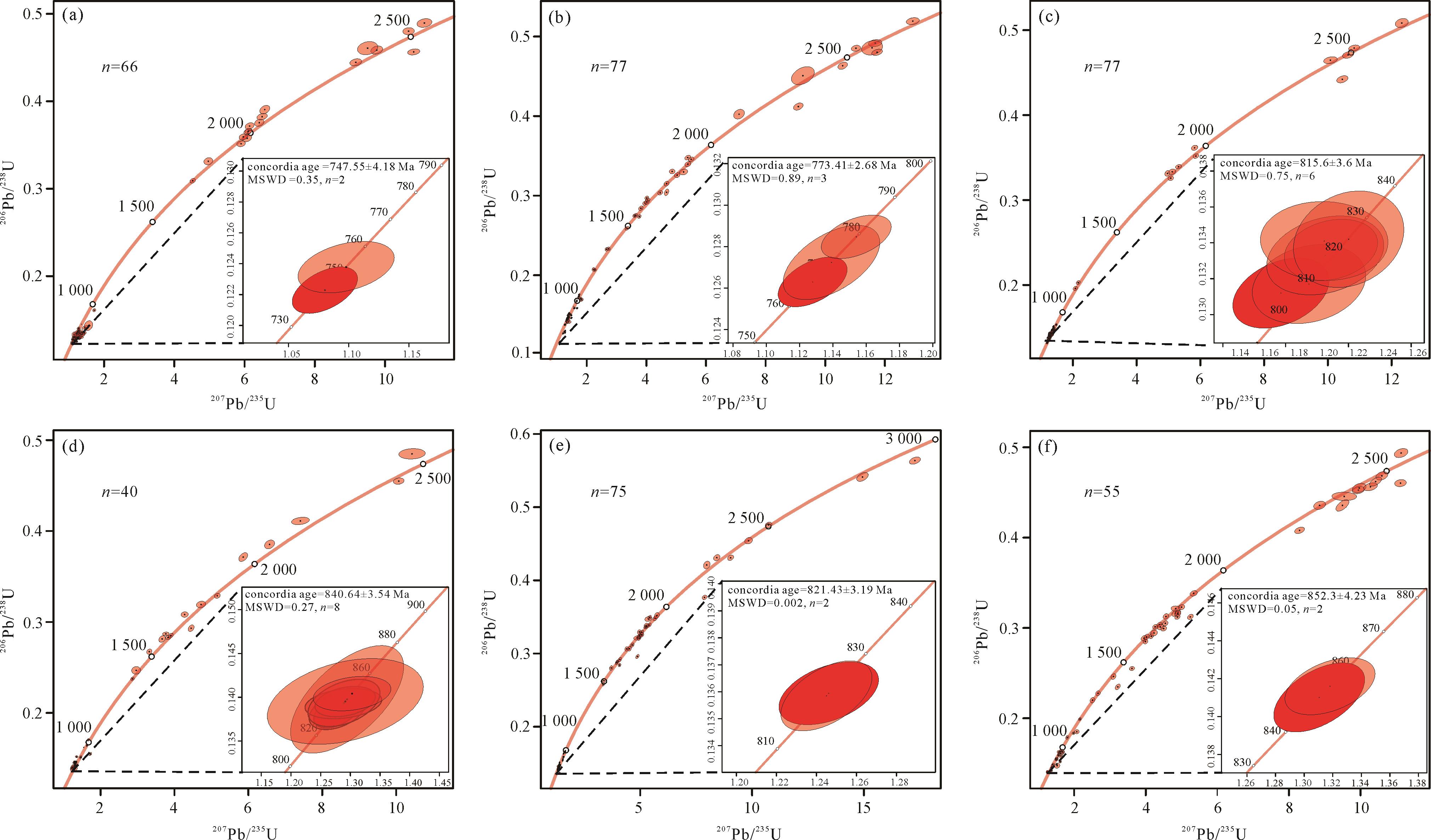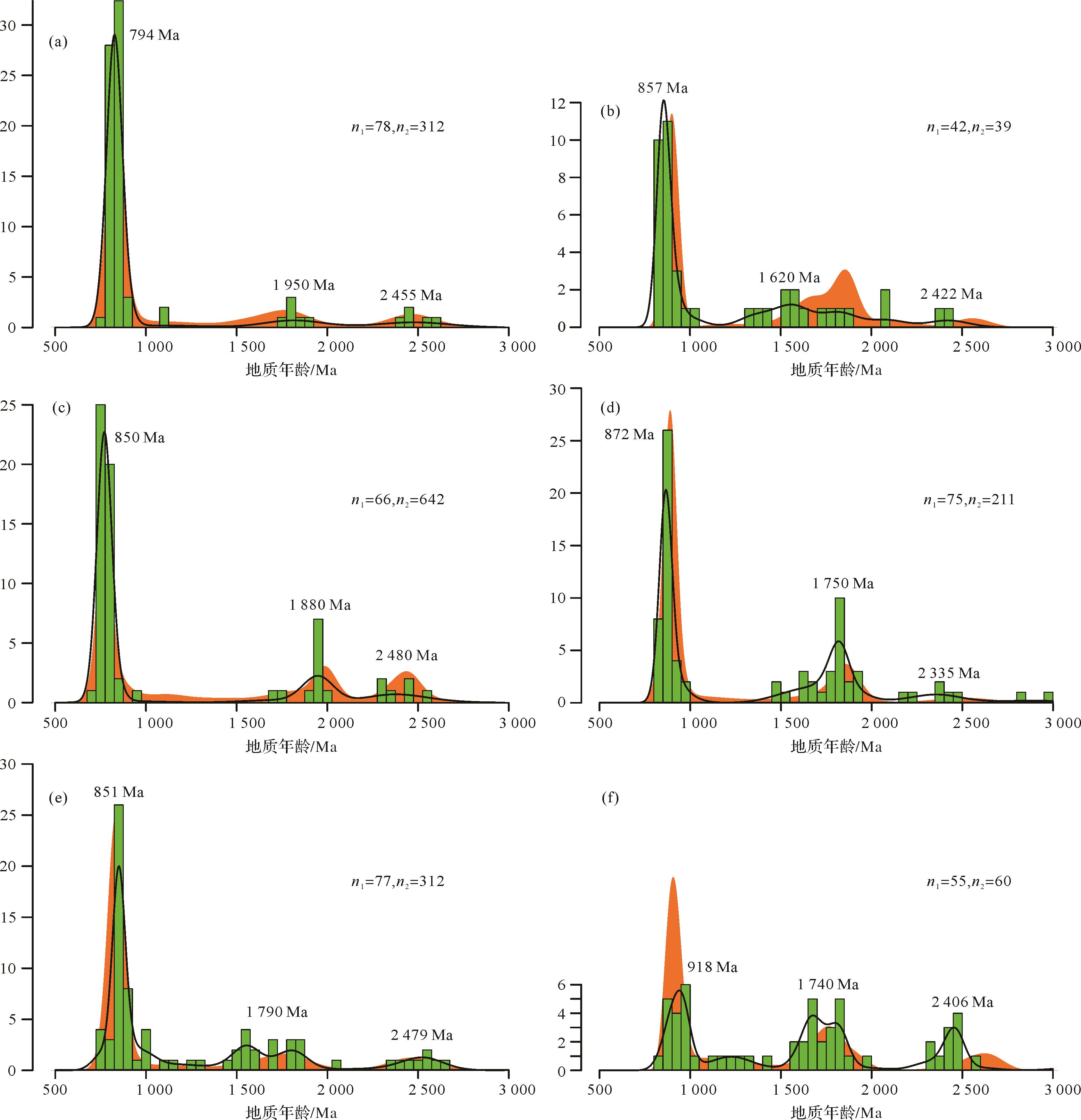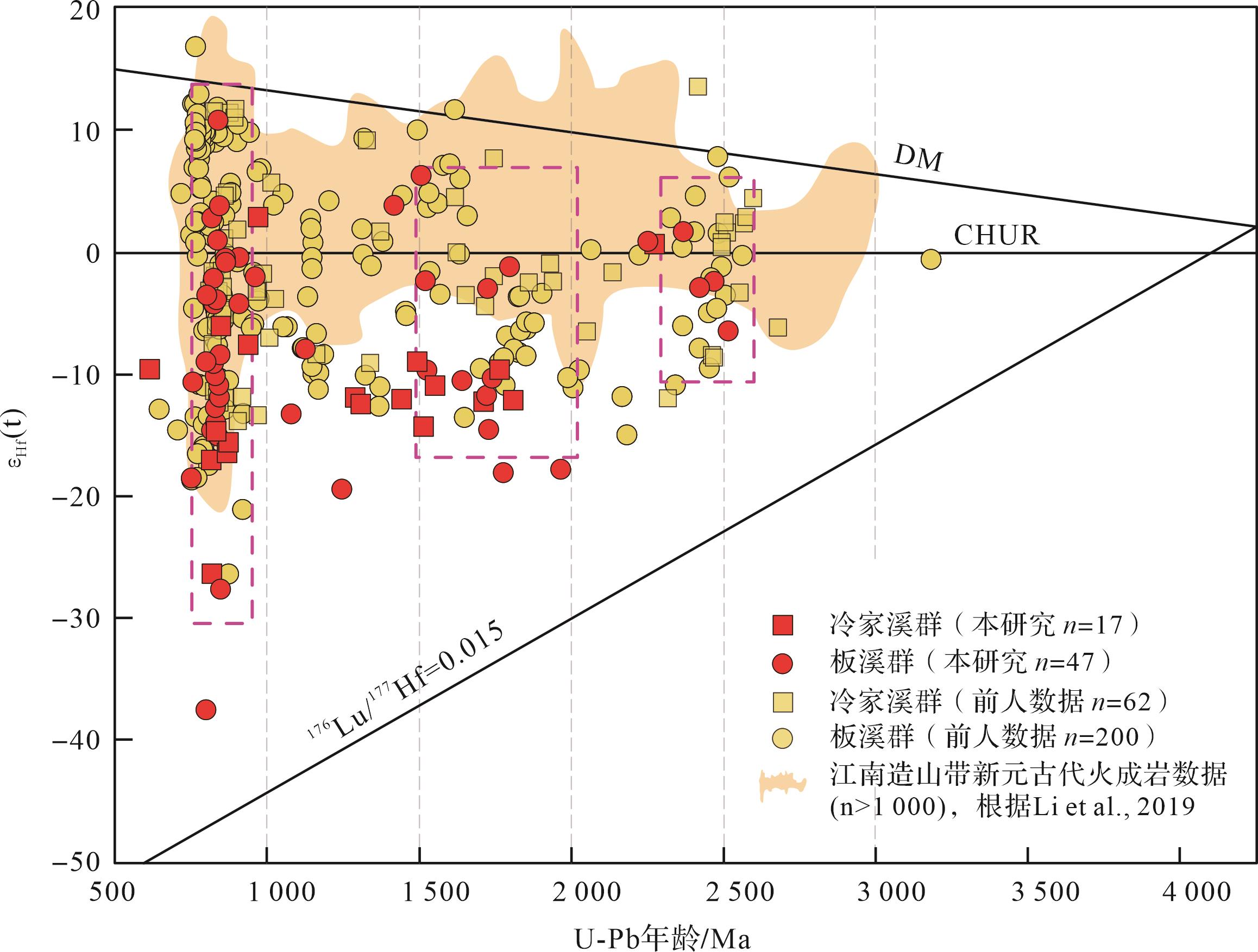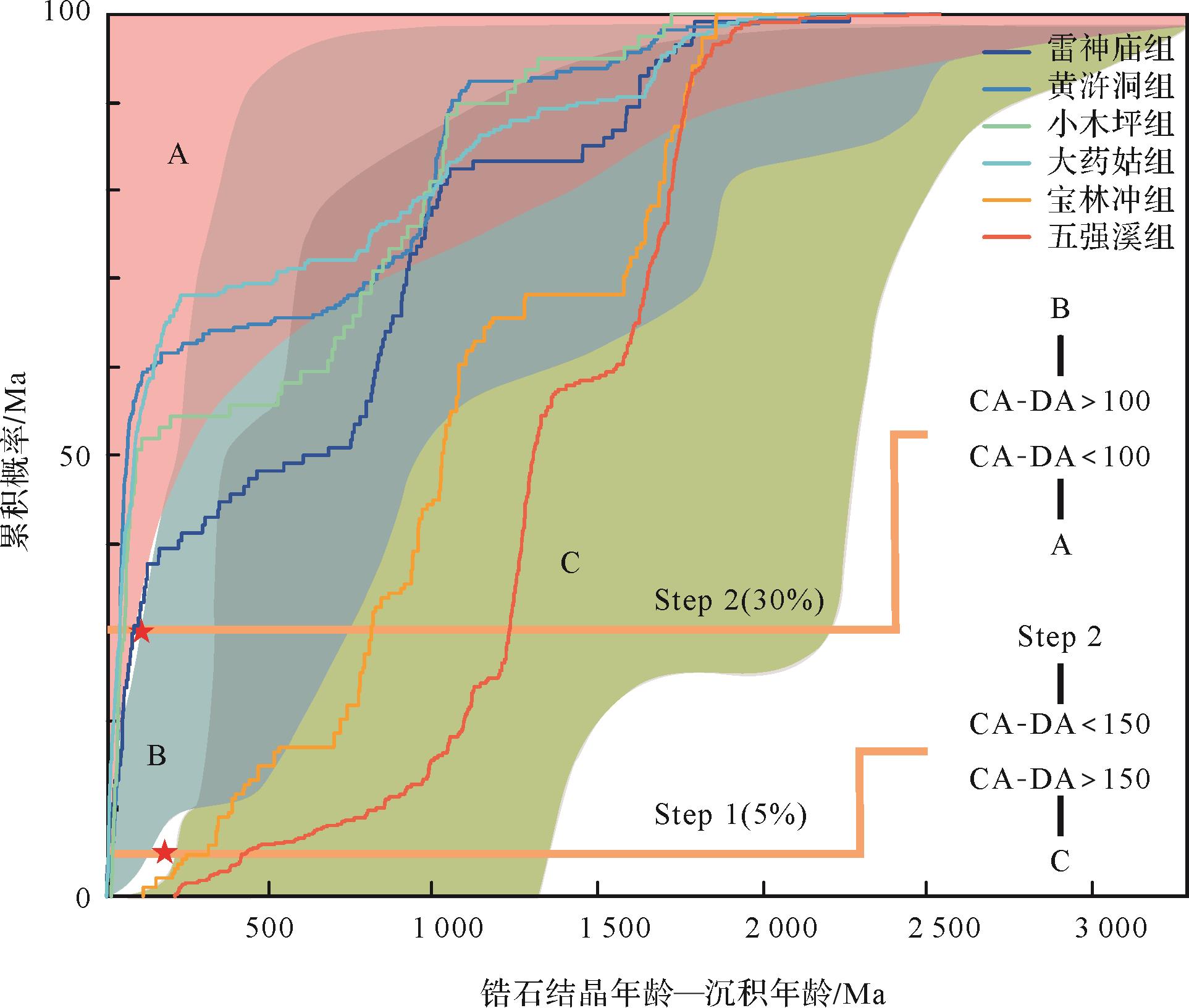|
[1]
|
Li Z X, Bogdanova S V, Collins A S, et al. Assembly, configuration, and break-up history of Rodinia: A synthesis[J]. Precambrian Research, 2008, 160(1/2): 179-210. |
|
[2]
|
周传明,袁训来,肖书海,等. 中国埃迪卡拉纪综合地层和时间框架[J]. 中国科学:地球科学,2019,49(1):7-25.
Zhou Chuanming, Yuan Xunlai, Xiao Shuhai, et al. Ediacaran integrative stratigraphy and timescale of China[J]. Science China Earth Sciences, 2019, 49(1): 7-25. |
|
[3]
|
Zhao L, Zhai M G, Zhou X W, et al. Geochronology and geochemistry of a suite of mafic rocks in Chencai area, South China: Implications for petrogenesis and tectonic setting[J]. Lithos, 2015, 236-237: 226-244. |
|
[4]
|
Yao J L, Cawood P A, Shu L S, et al. Jiangnan orogen, South China: A ~970-820 Ma Rodinia margin accretionary belt[J]. Earth-Science Reviews, 2019, 196: 102872. |
|
[5]
|
王孝磊,周金城,陈昕,等. 江南造山带的形成与演化[J]. 矿物岩石地球化学通报,2017,36(5):714-735.
Wang Xiaolei, Zhou Jincheng, Chen Xin, et al. Formation and evolution of the Jiangnan orogen[J]. Bulletin of Mineralogy, Petrology and Geochemistry, 2017, 36(5): 714-735. |
|
[6]
|
张克信,徐亚东,何卫红,等. 中国新元古代青白口纪早期(1000~820Ma)洋陆分布[J]. 地球科学,2018,43(11):3837-3852.
Zhang Kexin, Xu Yadong, He Weihong, et al. Oceanic and continental blocks distribution during Neoproterozoic Early Qingbaikouan period (1000-820 Ma) in China[J]. Earth Science, 2018, 43(11): 3837-3852. |
|
[7]
|
田洋. 江南造山带西段青白口系—寒武系火山—沉积建造及对华南构造演化的启示[D]. 武汉:中国地质大学,2021.
Tian Yang. The Qingbaikouan-Cambrian volcanic and sedimentary sequences in the western Jiangnan orogen and its implication for tectonic evolution of South China[D]. Wuhan: China University of Geosciences, 2021. |
|
[8]
|
黄思访. 江南造山带的形成与演化:来自新元古代岩浆岩的启示[D]. 武汉:中国地质大学,2021.
Huang Sifang. The formation and evolution of the Jiangnan orogen: Implication from the Neoproterozoic magmatic rock[D]. Wuhan: China University of Geosciences, 2021. |
|
[9]
|
郭令智,施央申,马瑞士,等. 中国东南部地体构造的研究[J]. 南京大学学报(自然科学版),1984,20(4):732-739.
Guo Lingzhi, Shi Yangshen, Ma Ruishi, et al. Tectonostratigraphic terranes of southeast China[J]. Journal of Nanjing University (Natural Sciences), 1984, 20(4): 732-739. |
|
[10]
|
陈旭,张元动,樊隽轩,等. 广西运动的进程:来自生物相和岩相带的证据[J]. 中国科学:地球科学,2012,42(11):1617-1626.
Chen Xu, Zhang Yuandong, Fan Junxuan, et al. Onset of the Kwangsian orogeny as evidenced by biofacies and lithofacies[J]. Science China: Earth Sciences, 2012, 42(11): 1617-1626. |
|
[11]
|
Zhao G C. Jiangnan orogen in South China: Developing from divergent double subduction[J]. Gondwana Research, 2015, 27(3): 1173-1180. |
|
[12]
|
Shu L S, Wang J Q, Yao J L. Tectonic evolution of the eastern Jiangnan region, South China: New findings and implications on the assembly of the Rodinia supercontinent[J]. Precambrian Research, 2019, 322: 42-65. |
|
[13]
|
Cawood P A, Wang Y J, Xu Y J, et al. Locating South China in Rodinia and Gondwana: A fragment of greater India lithosphere?[J]. Geology, 2013, 41(8): 903-906. |
|
[14]
|
Chen X, Wang X L, Wang D, et al. Contrasting mantle-crust melting processes within orogenic belts: Implications from two episodes of mafic magmatism in the western segment of the Neoproterozoic Jiangnan orogen in South China[J]. Precambrian Research, 2018, 309: 123-137. |
|
[15]
|
Guo L H, Gao R. Potential-field evidence for the tectonic boundaries of the central and western Jiangnan belt in South China[J]. Precambrian Research, 2018, 309: 45-55. |
|
[16]
|
Wang X L, Zhou J C, Griffin W L, et al. Detrital zircon geochronology of Precambrian basement sequences in the Jiangnan orogen: Dating the assembly of the Yangtze and Cathaysia Blocks[J]. Precambrian Research, 2007, 159(1/2): 117-131. |
|
[17]
|
Li Z X, Zhang L H, Powell C M. South China in Rodinia: Part of the missing link between Australia–East Antarctica and Laurentia?[J]. Geology, 1995, 23(5): 407-410. |
|
[18]
|
Li X H, Li Z X, Ge W C, et al. Neoproterozoic granitoids in South China: Crustal melting above a mantle plume at ca.825 Ma?[J]. Precambrian Research, 2003, 122(1/2/3/4): 45-83. |
|
[19]
|
Ye M F, Li X H, Li W X, et al. SHRIMP zircon U–Pb geochronological and whole-rock geochemical evidence for an Early Neoproterozoic Sibaoan magmatic arc along the southeastern margin of the Yangtze Block[J]. Gondwana Research, 2007, 12(1/2): 144-156. |
|
[20]
|
Li W X, Li X H, Li Z X, et al. Obduction-type granites within the NE Jiangxi ophiolite: Implications for the final amalgamation between the Yangtze and Cathaysia Blocks[J]. Gondwana Research, 2008, 13(3): 288-301. |
|
[21]
|
Li X H, Li W X, Li Z X, et al. Amalgamation between the Yangtze and Cathaysia Blocks in South China: Constraints from SHRIMP U–Pb zircon ages, geochemistry and Nd-Hf isotopes of the Shuangxiwu volcanic rocks[J]. Precambrian Research, 2009, 174(1/2): 117-128. |
|
[22]
|
Zhou M F, Yan D P, Kennedy A K, et al. SHRIMP U-Pb zircon geochronological and geochemical evidence for Neoproterozoic arc-magmatism along the western margin of the Yangtze Block, South China[J]. Earth and Planetary Science Letters, 2002, 196(1/2): 51-67. |
|
[23]
|
Zheng Y F, Zhang S B, Zhao Z F, et al. Contrasting zircon Hf and O isotopes in the two episodes of Neoproterozoic granitoids in South China: Implications for growth and reworking of continental crust[J]. Lithos, 2007, 96(1/2): 127-150. |
|
[24]
|
舒良树. 华南构造演化的基本特征[J]. 地质通报,2012,31(7):1035-1053.
Shu Liangshu. An analysis of principal features of tectonic evolution in South China Block[J]. Geological Bulletin of China, 2012, 31(7): 1035-1053. |
|
[25]
|
Shu L S, Yao J L, Wang B, et al. Neoproterozoic plate tectonic process and Phanerozoic geodynamic evolution of the South China Block[J]. Earth-Science Reviews, 2021, 216: 103596. |
|
[26]
|
Xia Y, Xu X S, Niu Y L, et al. Neoproterozoic amalgamation between Yangtze and Cathaysia Blocks: The magmatism in various tectonic settings and continent-arc-continent collision[J]. Precambrian Research, 2018, 309: 56-87. |
|
[27]
|
Yao J L, Cawood P A, Shu L S, et al. An Early Neoproterozoic accretionary prism ophiolitic mélange from the western Jiangnan orogenic belt, South China[J]. The Journal of Geology, 2016, 124(5): 587-601. |
|
[28]
|
Zhou J C, Wang X L, Qiu J S, et al. Geochemistry of Meso- and Neoproterozoic mafic-ultramafic rocks from northern Guangxi, China: Arc or plume magmatism?[J]. Geochemical Journal, 2004, 38(2): 139-152. |
|
[29]
|
Zhang K J. A mediterranean-style model for Early Neoproterozoic amalgamation of South China[J]. Journal of Geodynamics, 2017, 105: 1-10. |
|
[30]
|
Zhao J H, Zhou M F, Yan D P, et al. Reappraisal of the ages of Neoproterozoic strata in South China: No connection with the Grenvillian orogeny[J]. Geology, 2011, 39(4): 299-302. |
|
[31]
|
Yao J L, Shu L S, Santosh M, et al. Neoproterozoic arc-related mafic–ultramafic rocks and syn-collision granite from the western segment of the Jiangnan orogen, South China: Constraints on the Neoproterozoic assembly of the Yangtze and Cathaysia Blocks[J]. Precambrian Research, 2014, 243: 39-62. |
|
[32]
|
Zhang C L, Zou H B, Zhu Q B, et al. Late Mesoproterozoic to Early Neoproterozoic ridge subduction along southern margin of the Jiangnan orogen: New evidence from the northeastern Jiangxi ophiolite (NJO), South China[J]. Precambrian Research, 2015, 268: 1-15. |
|
[33]
|
Zhang H, Li T D, Xie Y, et al. Geochronology and tectonic evolution of the west section of the Jiangnan orogenic belt[J]. Acta Geologica Sinica - English Edition, 2015, 89(5): 1497-1515. |
|
[34]
|
Wang X S, Gao J, Klemd R, et al. Early Neoproterozoic multiple arc-back-arc system formation during subduction-accretion processes between the Yangtze and Cathaysia Blocks: New constraints from the supra-subduction zone NE Jiangxi ophiolite (South China)[J]. Lithos, 2015, 236-237: 90-105. |
|
[35]
|
Zhang C L, Li H K, Santosh M. Revisiting the tectonic evolution of South China: Interaction between the Rodinia superplume and plate subduction?[J]. Terra Nova, 2013, 25(3): 212-220. |
|
[36]
|
Merdith A S, Collins A S, Williams S E, et al. A full-plate global reconstruction of the Neoproterozoic[J]. Gondwana Research, 2017, 50: 84-134. |
|
[37]
|
Zhang Y Z, Wang Y J, Zhang Y H, et al. Neoproterozoic assembly of the Yangtze and Cathaysia Blocks: Evidence from the Cangshuipu Group and associated rocks along the central Jiangnan orogen, South China[J]. Precambrian Research, 2015, 269: 18-30. |
|
[38]
|
杨雪,张玉芝,崔翔,等. 湘东北新元古代冷家溪群沉积岩的地球化学特征和碎屑锆石U-Pb年代学[J]. 地球科学,2020,45(9):3461-3474.
Yang Xue, Zhang Yuzhi, Cui Xiang, et al. Geochemistry and detrital zircon U-Pb ages of sedimentary rocks from Neoproterozoic Lengjiaxi Group in NE Hunan pro-vince[J]. Earth Science, 2020, 45(9): 3461-3474. |
|
[39]
|
柏道远,蒋启生,李彬,等. 湘东北冷家溪群沉积岩地球化学特征及其构造意义[J]. 地质科技通报,2021,40(1):1-13,26.
Bai Daoyuan, Jiang Qisheng, Li Bin, et al. Geochemistry and tectonic implication of the sedimentary rocks in Lengjiaxi Group in northeastern Hunan[J]. Bulletin of Geological Science and Technology, 2021, 40(1): 1-13, 26. |
|
[40]
|
Yao J L, Shu L S, Cawood P A, et al. Constraining timing and tectonic implications of Neoproterozoic metamorphic event in the Cathaysia Block, South China[J]. Precambrian Research, 2017, 293: 1-12. |
|
[41]
|
Wang Y J, Zhang A M, Cawood P A, et al. Geochronological, geochemical and Nd–Hf–Os isotopic fingerprinting of an Early Neoproterozoic arc–back-arc system in South China and its accretionary assembly along the margin of Rodinia[J]. Precambrian Research, 2013, 231: 343-371. |
|
[42]
|
田洋,金巍,王晶,等. 江南造山带中段冷家溪群沉积物源及构造背景:以岳阳地区黄浒洞组为例[J]. 地球科学,2021,46(4):1328-1348.
Tian Yang, Jin Wei, Wang Jing, et al. Provenance and tectonic setting of Lengjiaxi Group in the central Jiangnan orogen: A case study of Huanghudong Formation, Yueyang area[J]. Earth Science, 2021, 46(4): 1328-1348. |
|
[43]
|
湖南省地质矿产局. 湖南省区域地质志[M]. 北京:地质出版社,1988.
Hunan Bureau of Geology and Mineral Resources. Regional geology of Hunan province[M]. Beijing: Geological Publishing House, 1988. |
|
[44]
|
广西壮族自治区地质矿产局. 广西壮族自治区区域地质志[M]. 北京:地质出版社,1985.
Bureau of Geology and Mineral Resources of Guangxi Zhuang Autonomous Region. Regional geology of Guangxi Zhuang Autonomous Region[M]. Beijing: Geological Publishing House, 1985. |
|
[45]
|
贵州省地质矿产局. 贵州省区域地质志[M]. 北京:地质出版社,1987.
Bureau of Geology and Mineral Resources of Guizhou Province. Regional geology of Guizhou province[M]. Beijing: Geological Publishing House, 1987. |
|
[46]
|
江西省地质矿产局. 江西省区域地质志[M]. 北京:地质出版社,1984.
Jiangxi Bureau of Geology and Mineral Resources. Regional geology of Jiangxi province[M]. Beijing: Geological Publishing House, 1984. |
|
[47]
|
陈建书,戴传固,彭成龙,等. 湘黔桂地区新元古代“下江群”地层划分对比研究:重新启用下江系的探讨[J]. 地质论评,2016,62(5):1093-1114.
Chen Jianshu, Dai Chuangu, Peng Chenglong, et al. Study on stratigraphical division and correlation of the Neoproterozoic “Xiajiang Group” in Hunan, Guizhou and Guangxi province: Discuss on the reboot of Xiajiang System[J]. Geological Review, 2016, 62(5): 1093-1114. |
|
[48]
|
伍实. 广西晚元古代本洞岩体同位素年代学研究[J]. 地球化学,1979,8(3):187-194.
Wu Shi. A study on isotopic geochronology of Late Protorozoic Bendong intrusive massif, Guangxi, China[J]. Geochimica, 1979, 8(3): 187-194. |
|
[49]
|
车勤建,伍光英,唐晓珊,等. 湘东北中元古代冷家溪群的解体及其地质意义[J]. 华南地质与矿产,2005(1):47-53,71.
Che Qinjian, Wu Guangying, Tang Xiaoshan, et al. Disintegration of the Mesoproterozoic Lengjiaxi Group in northeast Hunan province[J]. Geology and Mineral Resources of South China, 2005(1): 47-53, 71. |
|
[50]
|
唐晓珊. 湖南冷家溪群岩石地层的研究[J]. 湖南地质,1989,8(2):1-9.
Tang Xiaoshan. Lithostratigraphic study of Lengjiaxi Group in Hunan[J]. Hunan Geology, 1989, 8(2): 1-9. |
|
[51]
|
钟玉芳,马昌前,佘振兵,等. 江西九岭花岗岩类复式岩基锆石SHRIMP U-Pb年代学[J]. 地球科学,2005,30(6):685-691.
Zhong Yufang, Ma Changqian, She Zhenbing, et al. SHRIMP U-Pb zircon geochronology of the Jiuling granitic complex batholith in Jiangxi province[J]. Earth Science, 2005, 30(6): 685-691. |
|
[52]
|
张芳荣,黄新曙. 江西九岭南缘九仙汤侵入体的锆石U-Pb定年[J]. 资源调查与环境,2008,29(4):252-256.
Zhang Fangrong, Huang Xinshu. Zircon U-Pb dating of Jiuxiantang intrusion in the southern margin of Jiuling Mountain range, Jiangxi province[J]. Resources Survey & Environment, 2008, 29(4): 252-256. |
|
[53]
|
薛怀民,马芳,宋永勤,等. 江南造山带东段新元古代花岗岩组合的年代学和地球化学:对扬子地块与华夏地块拼合时间与过程的约束[J]. 岩石学报,2010,26(11):3215-3244.
Xue Huaimin, Ma Fang, Song Yongqin, et al. Geochronology and geochemisty of the Neoproterozoic granitoid association from eastern segment of the Jiangnan orogen, China: Constraints on the timing and process of amalgamation between the Yangtze and Cathaysia Blocks[J]. Acta Petrologica Sinica, 2010, 26(11): 3215-3244. |
|
[54]
|
Wang X L, Zhou J C, Qiu J S, et al. LA-ICP-MS U-Pb zircon geochronology of the Neoproterozoic igneous rocks from northern Guangxi, South China: Implications for tectonic evolution[J]. Precambrian Research, 2006, 145(1/2): 111-130. |
|
[55]
|
Wang X L, Jiang S Y, Dai B Z, et al. Age, geochemistry and tectonic setting of the Neoproterozoic (ca 830Ma) gabbros on the southern margin of the North China Craton[J]. Precambrian Research, 2011, 190(1/2/3/4): 35-47. |
|
[56]
|
Wang X L, Zhou J C, Griffin W L, et al. Geochemical zonation across a Neoproterozoic orogenic belt: Isotopic evidence from granitoids and metasedimentary rocks of the Jiangnan orogen, China[J]. Precambrian Research, 2014, 242: 154-71. |
|
[57]
|
Wang X L, Zhou J C, Qiu J S, et al. Geochronology and geochemistry of Neoproterozoic mafic rocks from western Hunan, South China: Implications for petrogenesis and post-orogenic extension[J]. Geological Magazine, 2008, 145(2): 215-233. |
|
[58]
|
Zhou J C, Wang X L, Qiu J S. Geochronology of Neoproterozoic mafic rocks and sandstones from northeastern Guizhou, South China: Coeval arc magmatism and sedimentation[J]. Precambrian Research, 2009, 170(1/2): 27-42. |
|
[59]
|
高林志,杨明桂,丁孝忠,等. 华南双桥山群和河上镇群凝灰岩中的锆石SHRIMP U-Pb年龄:对江南新元古代造山带演化的制约[J]. 地质通报,2008,27(10):1744-1751.
Gao Linzhi, Yang Minggui, Ding Xiaozhong, et al. SHRIMP U-Pb zircon dating of tuff in the Shuangqiaoshan and Heshangzhen Groups in South China: Constraints on the evolution of the Jiangnan Neoproterozoic orogenic belt[J]. Geological Bulletin of China, 2008, 27(10): 1744-1751. |
|
[60]
|
Wang J, Li Z X. History of Neoproterozoic rift basins in South China: Implications for Rodinia break-up[J]. Precambrian Research, 2003, 122(1/2/3/4): 141-158. |
|
[61]
|
孙海清,黄建中,郭乐群,等. 湖南冷家溪群划分及同位素年龄约束[J]. 华南地质与矿产,2012,28(1):20-26.
Sun Haiqing, Huang Jianzhong, Guo Lequn, et al. Subdivision and isotopic age of Lengjiaxi Group in Hunan province[J]. Geology and Mineral Resources of South China, 2012, 28(1): 20-26. |
|
[62]
|
湖南省地质调查院. 中国区域地质志湖南志[M]. 北京:地质出版社,2017.
Hunan Provincial Geological Survey. Regional geology of China: Hunan chronicles[M]. Beijing: Geological Publishing House, 2017. |
|
[63]
|
Wang W, Zhou M F. Sedimentary records of the Yangtze Block (South China) and their correlation with equivalent Neoproterozoic sequences on adjacent continents[J]. Sedimentary Geology, 2012, 265-266: 126-142. |
|
[64]
|
覃永军,杜远生,牟军,等. 黔东南地区新元古代下江群的地层年代及其地质意义[J]. 地球科学,2015,40(7):1107-1120.
Qin Yongjun, Du Yuansheng, Mou Jun, et al. Geochronology of Neoproterozoic Xiajiang Group in southeast Guizhou, South China, and its geological implications[J]. Earth Science, 2015, 40(7): 1107-1120. |
|
[65]
|
崔晓庄,江新胜,邓奇,等. 桂北地区丹洲群锆石U-Pb年代学及对华南新元古代裂谷作用期次的启示[J]. 大地构造与成矿学,2016,40(5):1049-1063.
Cui Xiaozhuang, Jiang Xinsheng, Deng Qi, et al. Zircon U-Pb geochronological results of the Danzhou Group in northern Guangxi and their implications for the Neoproterozoic rifting stages in South China[J]. Geotectonica et Metallogenia, 2016, 40(5): 1049-1063. |
|
[66]
|
Wang J Q, Shu L S, Santosh M. U-Pb and Lu-Hf isotopes of detrital zircon grains from Neoproterozoic sedimentary rocks in the central Jiangnan orogen, South China: Implications for Precambrian crustal evolution[J]. Precambrian Research, 2017, 294: 175-188. |
|
[67]
|
Li D H, Yang Z N, Liu Y, et al. Timing and provenance transition of the Neoproterozoic Wuling unconformity and Xihuangshan unconformity of the Yangtze Block: Responses to peripheral orogenic events[J]. Minerals, 2022, 12(5): 596. |
|
[68]
|
Chen X, Wang D, Wang X L, et al. Neoproterozoic chromite-bearing high-Mg diorites in the western part of the Jiangnan orogen, southern China: Geochemistry, petrogenesis and tectonic implications[J]. Lithos, 2014, 200-201: 35-48. |
|
[69]
|
Sláma J, Košler J, Condon D J, et al. Plešovice zircon: A new natural reference material for U-Pb and Hf isotopic microanalysis[J]. Chemical Geology, 2008, 249(1/2): 1-35. |
|
[70]
|
Liu Y S, Gao S, Hu Z C, et al. Continental and oceanic crust recycling-induced Melt-Peridotite interactions in the trans-North China orogen: U-Pb dating, Hf isotopes and trace elements in zircons from mantle xenoliths[J]. Journal of Petrology, 2010, 51(1/2): 537-571. |
|
[71]
|
Andersen T. Correction of common lead in U-Pb analyses that do not report 204Pb[J]. Chemical Geology, 2002, 192(1/2): 59-79. |
|
[72]
|
Ludwig K R. ISOPLOT 3.00: A geochronological toolkit for Microsoft Excel[M]. Berkeley: Berkeley Geochronology Center, 2003. |
|
[73]
|
Jackson S E, Pearson N J, Griffin W L, et al. The application of laser ablation-inductively coupled plasma-mass spectrometry to in situ U-Pb zircon geochronology[J]. Chemical Geology, 2004, 211(1/2): 47-69. |
|
[74]
|
Chu N C, Taylor R N, Chavagnac V, et al. Hf isotope ratio analysis using multi-collector inductively coupled plasma mass spectrometry: An evaluation of isobaric interference corrections[J]. Journal of Analytical Atomic Spectrometry, 2002, 17(12): 1567-1574. |
|
[75]
|
Jonathan Patchett P, Kouvo O, Hedge C E, et al. Evolution of continental crust and mantle heterogeneity: Evidence from Hf isotopes[J]. Contributions to Mineralogy and Petrology, 1982, 78(3): 279-297. |
|
[76]
|
Xu P, Wu F Y, Xie L W, et al. Hf isotopic compositions of the standard zircons for U-Pb dating[J]. Chinese Science Bulletin, 2004, 49(15): 1642-1648. |
|
[77]
|
Machado N, Simonetti A. U-Pb dating and Hf isotopic composition of zircons by laser ablation-MC-ICP-MS[M]//Sylvester P. Laser-Ablation-ICPMS in the Earth sciences: Principles and applications. Ottawa: Mineralogical Association of Canada, 2001. |
|
[78]
|
Iizuka T, Hirata T. Improvements of precision and accuracy in in situ Hf isotope microanalysis of zircon using the laser ablation-MC-ICPMS technique[J]. Chemical Geology, 2005, 220(1/2): 121-137. |
|
[79]
|
Song G Y, Wang X Q, Shi X Y, et al. New U-Pb age constraints on the upper Banxi Group and synchrony of the Sturtian glaciation in South China[J]. Geoscience Frontiers, 2017, 8(5): 1161-1173. |
|
[80]
|
Wang X C, Li X H, Li Z X, et al. Episodic Precambrian crust growth: Evidence from U-Pb ages and Hf-O isotopes of zircon in the Nanhua Basin, central South China[J]. Precambrian Research, 2012, 222-223: 386-403. |
|
[81]
|
Wang W, Wang F, Chen F K, et al. Detrital zircon ages and Hf‐Nd isotopic composition of Neoproterozoic sedimentary rocks in the Yangtze Block: Constraints on the deposition age and provenance[J]. The Journal of Geology, 2010, 118(1): 79-94. |
|
[82]
|
孟庆秀,张健,耿建珍,等. 湘中地区冷家溪群和板溪群锆石U-Pb年龄、Hf同位素特征及对华南新元古代构造演化的意义[J]. 中国地质,2013,40(1):191-216.
Meng Qingxiu, Zhang Jian, Geng Jianzhen, et al. Zircon U-Pb age and Hf isotope compositions of Lengjiaxi and Baxi Groups in middle Hunan pro-vince: Implications for the Neoproterozoic tectonic evolution in South China[J]. Geology in China, 2013, 40(1): 191-216. |
|
[83]
|
张玉芝,王岳军,范蔚茗,等. 江南隆起带新元古代碰撞结束时间:沧水铺砾岩上下层位的U-Pb年代学证据[J]. 大地构造与成矿学,2011,35(1):32-46.
Zhang Yuzhi, Wang Yuejun, Fan Weiming, et al. Geochronological constraints on the Neoproterozoic collision along the Jiangnan uplift: Evidence from studies on the Neoproterozoic basal conglomerates at the Cangshuipu area, Hunan province[J]. Geotectonica et Metallogenia, 2011, 35(1): 32-46. |
|
[84]
|
张菲菲,王岳军,范蔚茗,等. 江南隆起带中段新元古代花岗岩锆石U-Pb年代学和Hf同位素组成研究[J]. 大地构造与成矿学,2011,35(1):73-84.
Zhang Feifei, Wang Yuejun, Fan Weiming, et al. Zircon U-Pb geochronology and Hf isotopes of the Neoproterozoic granites in the central of Jiangnan uplift[J]. Geotectonica et Metallogenia, 2011, 35(1): 73-84. |
|
[85]
|
Wang L J, Griffin W L, Yu J H, et al. Precambrian crustal evolution of the Yangtze Block tracked by detrital zircons from Neoproterozoic sedimentary rocks[J]. Precambrian Research, 2010, 177(1/2): 131-134. |
|
[86]
|
Gao L Z, Ding X Z, Zhang C H, et al. Revised chronostratigraphic framework of the metamorphic strata in the Jiangnan orogenic belt, South China and its tectonic implications[J]. Acta Geologica Sinica -English Edition, 2012, 86(2): 339-349. |
|
[87]
|
何垚砚,牛志军,宋芳,等. 鄂东南新元古界冷家溪群大药菇组地质特征及区域对比[J]. 地层学杂志,2017,41(2):195-208.
He Yaoyan, Niu Zhijun, Song Fang, et al. Geological characteristics and stratigraphic correlation of the Neoproterozoic Dayaogu Formation of the Lengjiaxi Group in southeastern Hubei province[J]. Journal of Stratigraphy, 2017, 41(2): 195-208. |
|
[88]
|
Wang W, Zhou M F, Yan D P, et al. Detrital zircon record of Neoproterozoic active-margin sedimentation in the eastern Jiangnan orogen, South China[J]. Precambrian Research, 2013, 235: 1-19. |
|
[89]
|
Wang W, Zhou M F, Yan D P, et al. Depositional age, provenance, and tectonic setting of the Neoproterozoic Sibao Group, southeastern Yangtze Block, South China[J]. Precambrian Research, 2012, 192-195: 107-124. |
|
[90]
|
Wang X L, Shu L S, Xing G F, et al. Post-orogenic extension in the eastern part of the Jiangnan orogen: Evidence from ca 800-760Ma volcanic rocks[J]. Precambrian Research, 2012, 222-223: 404-423. |
|
[91]
|
汪正江,许效松,杜秋定,等. 南华冰期的底界讨论:来自沉积学与同位素年代学证据[J]. 地球科学进展,2013,28(4):477-489.
Wang Zhengjiang, Xu Xiaosong, Du Qiuding, et al. Discussion on the bottom of Nanhua System: Evidences from sedimentology and isotopic geochronology[J]. Advances in Earth Science, 2013, 28(4): 477-489. |
|
[92]
|
田伟伦. 桂北四堡群物源分析与构造环境探讨[D]. 北京:中国地质大学(北京),2018.
Tian Weilun. A discussion on sedimentary provenance and tectonic setting of Sibao Group in northern Guangxi Zhuang autonomous region, South China[D]. Beijing: China University of Geosciences (Beijing), 2018. |
|
[93]
|
李利阳. 华南四堡群的年代与沉积地质特征[D]. 北京:中国地质大学(北京),2015.
Li Liyang. A discussion on the stratigraphic chronology and sedimentary characteristics of Sibao Group in South China[D]. Beijing: China University of Geosciences (Beijing), 2015. |
|
[94]
|
王敏,戴传固,王雪华,等. 贵州梵净山群沉积时代:来自原位锆石U-Pb测年证据[J]. 岩石矿物学杂志,2012,31(6):843-857.
Wang Min, Dai Chuangu, Wang Xuehua, et al. Sedimentation age of the Fanjingshan Group in east Guizhou province: Evidence from in-situ zircon LA-ICP-MS U-Pb dating[J]. Acta Petrologica et Mineralogica, 2012, 31(6): 843-857. |
|
[95]
|
Zhao J H, Zhou M F, Zheng J P. Constraints from zircon U–Pb ages, O and Hf isotopic compositions on the origin of Neoproterozoic peraluminous granitoids from the Jiangnan fold belt, South China[J]. Contributions to Mineralogy and Petrology, 2013, 166(5): 1505-1519. |
|
[96]
|
陈文西,王剑,付修根,等. 黔东南新元古界下江群甲路组沉积特征及其下伏岩体的锆石U-Pb年龄意义[J]. 地质论评,2007,53(1):126-131.
Chen Wenxi, Wang Jian, Fu Xiugen, et al. Sedimentary characteristics of the Jialu Formation and its underlying granite's U- Pb zircon age in southeast Guizhou, China[J]. Geological Review, 2007, 53(1): 126-131. |
|
[97]
|
马铁球,陈立新,柏道远,等. 湘东北新元古代花岗岩体锆石SHRIMP U-Pb年龄及地球化学特征[J]. 中国地质,2009,36(1):65-73.
Ma Tieqiu, Chen Lixin, Bai Daoyuan, et al. Zircon SHRIMP dating and geochemical characteristics of Neoproterozoic granites in southeastern Hunan[J]. Geology in China, 2009, 36(1): 65-73. |
|
[98]
|
高林志,陈峻,丁孝忠,等. 湘东北岳阳地区冷家溪群和板溪群凝灰岩SHRIMP锆石U-Pb年龄:对武陵运动的制约[J]. 地质通报,2011,30(7):1001-1008.
Gao Linzhi, Chen Jun, Ding Xiaozhong, et al. Zircon SHRIMP U-Pb dating of the tuff bed of Lengjiaxi and Banxi Groups, northeastern Hunan: Constraints on the Wuling movement[J]. Geological Bulletin of China, 2011, 30(7): 1001-1008. |
|
[99]
|
王剑,李献华, Duan T Z,等. 沧水铺火山岩锆石SHRIMP U-Pb年龄及“南华系”底界新证据[J]. 科学通报,2003,48(16):1726-1731.
Wang Jian, Li Xianhua, Duan T Z, et al. New evidence of the SHRIMP U-Pb age and the "South China" bottom boundary of the zircon of Cangshuipu volcanic rocks[J]. Chinese Science Bulletin, 2003, 48(16): 1726-1731. |
|
[100]
|
高林志,刘燕学,丁孝忠,等. 江南古陆中段沧水铺群锆石U-Pb年龄和构造演化意义[J]. 中国地质,2012,39(1):12-20.
Gao Linzhi, Liu Yanxue, Ding Xiaozhong, et al. SHRIMP dating of Cangshuipu Group in the middle part of the Jiangnan orogen and its implications for tectonic evolutions[J]. Geology in China, 2012, 39(1): 12-20. |
|
[101]
|
张世红,蒋干清,董进,等. 华南板溪群五强溪组SHRIMP锆石U-Pb年代学新结果及其构造地层学意义[J]. 中国科学:地球科学,2008,38(12):1496-1503.
Zhang Shihong, Jiang Ganqing, Dong Jin, et al. New results of SHRIMP zircon U-Pb chronology and their tectonic stratigraphic significance in the Wuqiangxi Formation of Banxi Group in South China[J]. Science China: Earth Sciences, 2008, 38(12): 1496-1503. |
|
[102]
|
Zhang Q R, Li X H, Feng L J, et al. A new age constraint on the onset of the Neoproterozoic glaciations in the Yangtze Platform, South China[J]. The Journal of Geology, 2008, 116(4): 423-429. |
|
[103]
|
杜秋定,汪正江,王剑,等. 湘中长安组碎屑锆石LA-ICP-MS U-Pb年龄及其地质意义[J]. 地质论评,2013,59(2):334-344.
Du Qiuding, Wang Zhengjiang, Wang Jian, et al. LA-ICP-MS U-Pb ages of detrital zircons from the Neoproterozoic Chang’an Formation in central Hunan and its geological implicatons[J]. Geological Review, 2013, 59(2): 334-344. |
|
[104]
|
赵彦彦,郑永飞. 全球新元古代冰期的记录和时限[J]. 岩石学报,2011,27(2):545-565.
Zhao Yanyan, Zheng Yongfei. Record and time of Neoproterozoic glaciations on Earth[J]. Acta Petrologica Sinica, 2011, 27(2): 545-565. |
|
[105]
|
Fanning C M, Link P K. U-Pb SHRIMP ages of Neoproterozoic (Sturtian) glaciogenic Pocatello Formation, southeastern Idaho[J]. Geology, 2004, 32(10): 881-884. |
|
[106]
|
Macdonald F A, Schmitz M D, Crowley J L, et al. Calibrating the Cryogenian[J]. Science, 2010, 327(5970): 1241-1243. |
|
[107]
|
Ma X, Yang K G, Li X G, et al. Neoproterozoic Jiangnan orogeny in southeast Guizhou, South China: Evidence from U–Pb ages for detrital zircons from the Sibao Group and Xiajiang Group[J]. Canadian Journal of Earth Sciences, 2016, 53(3): 219-230. |
|
[108]
|
Su H M, Jiang S Y, Mao J W, et al. U-Pb ages and Lu-Hf isotopes of detrital zircons from sedimentary units across the Mid-Neoproterozoic unconformity in the western Jiangnan orogen of South China and their tectonic implications[J]. The Journal of Geology, 2018, 126(2): 207-228. |
|
[109]
|
高林志,戴传固,刘燕学,等. 黔东地区下江群凝灰岩锆石SHRIMP U-Pb年龄及其地层意义[J]. 中国地质,2010,37(4):1071-1080.
Gao Linzhi, Dai Chuangu, Liu Yanxue, et al. Zircon SHRIMP U-Pb dating of the tuffaceous bed of Xiajiang Group in Guizhou province and its stratigraphic implication[J]. Geology in China, 2010, 37(4): 1071-1080. |
|
[110]
|
Yin C Y, Liu D Y, Gao L Z, et al. Lower boundary age of the Nanhua System and the Gucheng glacial stage: Evidence from SHRIMP II dating[J]. Chinese Science Bulletin, 2003, 48(16): 1657-1662. |
|
[111]
|
Shu L S, Faure M, Yu J H, et al. Geochronological and geochemical features of the Cathaysia Block (South China): New evidence for the Neoproterozoic breakup of Rodinia[J]. Precambrian Research, 2011, 187(3/4): 263-276. |
|
[112]
|
Wu R X, Zheng Y F, Wu Y B, et al. Reworking of juvenile crust: Element and isotope evidence from Neoproterozoic granodiorite in South China[J]. Precambrian Research, 2006, 146(3/4): 179-212. |
|
[113]
|
Wang J Q, Shu L S, Santosh M, et al. The Pre-Mesozoic crustal evolution of the Cathaysia Block, South China: Insights from geological investigation, zircon U-Pb geochronology, Hf isotope and REE geochemistry from the Wugongshan complex[J]. Gondwana Research, 2015, 28(1): 225-245. |
|
[114]
|
王鹏鸣,于津海,孙涛,等. 湘东新元古代沉积岩的地球化学和碎屑锆石年代学特征及其构造意义[J]. 岩石学报,2012,28(12):3841-3857.
Wang Pengming, Yu Jinhai, Sun Tao, et al. Geochemistry and detrital zircon geochronology of Neoproterozoic sedimentary rocks in eastern Hunan province and their tectonic significance[J]. Acta Petrologica Sinica, 2012, 28(12): 3841-3857. |
|
[115]
|
Li H, Zhou Z K, Algeo T J, et al. Geochronology and geochemi-stry of tuffaceous rocks from the Banxi Group: Implications for Neoproterozoic tectonic evolution of the southeastern Yangtze Block, South China[J]. Journal of Asian Earth Sciences, 2019, 177: 152-176. |
|
[116]
|
Wang K, Dong S W, Yao W H, et al. Nature and evolution of Pre-Neoproterozoic continental crust in South China: A review and tectonic implications[J]. Acta Geologica Sinica - English Edition, 2020, 94(6): 1731-1756. |
|
[117]
|
Xia Y, Xu X S, Zhu K Y. Paleoproterozoic S- and A-type granites in southwestern Zhejiang: Magmatism, metamorphism and implications for the crustal evolution of the Cathaysia basement[J]. Precambrian Research, 2012, 216-219: 177-207. |
|
[118]
|
Yu J H, Wang L J, O’Reilly S Y, et al. A Paleoproterozoic oro-geny recorded in a long-lived cratonic remnant (Wuyishan terrane), eastern Cathaysia Block, China[J]. Precambrian Research, 2009, 174(3/4): 347-363. |
|
[119]
|
Jiang C H, Wang X L, Wang S, et al. Paleoproterozoic basement beneath the eastern Cathaysia Block revealed by zircon xenocrysts from Late Mesozoic volcanics[J]. Precambrian Research, 2020, 350: 105922. |
|
[120]
|
Greentree M R, Li Z X, Li X H, et al. Late Mesoproterozoic to earliest Neoproterozoic basin record of the Sibao orogenesis in western South China and relationship to the assembly of Rodinia[J]. Precambrian Research, 2006, 151(1/2): 79-100. |
|
[121]
|
Zheng Y F, Zhang S B. Formation and evolution of Precambrian continental crust in South China[J]. Chinese Science Bulletin, 2007, 52(1): 1-12. |
|
[122]
|
Cheng X M, Cao S Y, Li J Y, et al. Early Paleoproterozoic tectono-magmatic and metamorphic evolution of the Yuanmou complex in the southwestern Yangzte Block[J]. Precambrian Research, 2022, 371: 106572. |
|
[123]
|
Yu J H, O’Reilly S Y, Wang L J, et al. Components and episodic growth of Precambrian crust in the Cathaysia Block, South China: Evidence from U-Pb ages and Hf isotopes of zircons in Neoproterozoic sediments[J]. Precambrian Research, 2010, 181(1/2/3/4): 97-114. |
|
[124]
|
Yao J L, Shu L S, Santosh M. Detrital zircon U-Pb geochronology, Hf-isotopes and geochemistry: New clues for the Precambrian crustal evolution of Cathaysia Block, South China[J]. Gondwana Research, 2011, 20(2/3): 553-567. |
|
[125]
|
周金城,王孝磊,邱检生. 江南造山带是否格林威尔期造山带?:关于华南前寒武纪地质的几个问题[J]. 高校地质学报,2008,14(1):64-72.
Zhou Jincheng, Wang Xiaolei, Qiu Jiansheng. Is the Jiangnan orogenic belt a Grenvillian orogenic belt: Some problems about the Precambrian geology of South China[J]. Geological Journal of China Universities, 2008, 14(1): 64-72. |
|
[126]
|
李江海,穆剑. 我国境内格林威尔期造山带的存在及其对中元古代末期超大陆再造的制约[J]. 地质科学,1999,34(3):259-272.
Li Jianghai, Mu Jian. Tectonic constraints from Chinese cratonic blocks for the reconstruction of Rodinia[J]. Chinese Journal of Geology, 1999, 34(3): 259-272. |
|
[127]
|
陆松年. 从罗迪尼亚到冈瓦纳超大陆:对新元古代超大陆研究几个问题的思考[J]. 地学前缘,2001,8(4):441-448.
Lu Songnian. From Rodinia to Gondwanaland supercontinents: Thinking about problems of researching Neoproterozoic supercontinents[J]. Earth Science Frontiers, 2001, 8(4): 441-448. |
|
[128]
|
周金城,王孝磊,邱检生. 江南造山带形成过程中若干新元古代地质事件[J]. 高校地质学报,2009,15(4):453-459.
Zhou Jincheng, Wang Xiaolei, Qiu Jianshneg. Some Neoproterozoic geological events involved in the development of the Jiangnan orogen[J]. Geological Journal of China Universities, 2009, 15(4): 453-459. |
|
[129]
|
周金城,王孝磊,邱检生,等. 南桥高度亏损N-MORB的发现及其地质意义[J]. 岩石矿物学杂志,2003,22(3):211-216.
Zhou Jincheng, Wang Xiaolei, Qiu Jiansheng, et al. The discovery of Nanqiao highly depleted N-MORB and geological significance[J]. Acta Petrologica et Mineralogica, 2003, 22(3): 211-216. |
|
[130]
|
贺安生,韩雄刚. 益阳火山岩特征及其形成构造环境分析[J]. 湖南地质,1992,11(4):269-274,277.
He Ansheng, Han Xionggang. Characteristics of the volcanic rocks in Yiyang and discussion about its tectonic setting[J]. Hunan Geology, 1992, 11(4): 269-274, 277. |
|
[131]
|
王孝磊,周金城,邱检生,等. 湖南中—新元古代火山—侵入岩地球化学及成因意义[J]. 岩石学报,2003,19(1):49-60.
Wang Xiaolei, Zhou Jincheng, Qiu Jiansheng, et al. Geochemi-stry of the Meso- Neoproterozoic volcanic-intrusive rocks from Hunan province and its petrogenic significances[J]. Acta Petrologica Sinica, 2003, 19(1): 49-60. |
|
[132]
|
凌长富,莫耀支,王砚耕. 贵州梵净山区层状超基性岩特征及其成因的初步探讨[J]. 地质科学,1975,10(4):343-351.
Ling Changfu, Mo Yaozhi, Wang Yangeng. Features of bedded ultrabasic rocks in Fanjinshan region of Guizhou province and a preliminary discussion of their origin[J]. Chinese Journal of Geology, 1975, 10(4): 343-351. |
|
[133]
|
肖禧砥. 湖南益阳元古代科马提岩发现鬣刺结构[J]. 科学通报,1988,33(4):286-288.
Xiao Xidi. Proterozoic Komati rock in Yiyang, Hunan province found hyena structure[J]. Chinese Science Bulletin, 1988, 33(4): 286-288. |
|
[134]
|
Zhang S B, Wu R X, Zheng Y F. Neoproterozoic continental accretion in South China: Geochemical evidence from the Fuchuan ophiolite in the Jiangnan orogen[J]. Precambrian Research, 2012, 220-221: 45-64. |
|
[135]
|
Zhang G W, Guo A L, Wang Y J, et al. Tectonics of South China continent and its implications[J]. Science China Earth Sciences, 2013, 56(11): 1804-1828. |
|
[136]
|
Zhang Y Z, Wang Y J, Geng H Y, et al. Early Neoproterozoic (∼850 Ma) back-arc basin in the central Jiangnan orogen (eastern South China): Geochronological and petrogenetic constraints from meta-basalts[J]. Precambrian Research, 2013, 231: 325-342. |
|
[137]
|
Zhang Y Z, Wang Y J, Fan W M, et al. Geochronological and geochemical constraints on the metasomatised source for the Neoproterozoic (∼825Ma) high-mg volcanic rocks from the Cangshuipu area (Hunan province) along the Jiangnan domain and their tectonic implications[J]. Precambrian Research, 2012, 220-221: 139-157. |
|
[138]
|
Huang S F, Wang W, Pandit M K, et al. Neoproterozoic S-type granites in the western Jiangnan orogenic belt, South China: Implications for petrogenesis and geodynamic significance[J]. Lithos, 2019, 342-343: 45-58. |
|
[139]
|
Wan L, Zeng Z X, Asimow P D, et al. Mid-Neoproterozoic mafic rocks in the western Jiangnan orogen, South China: Intracontinental rifting or subduction?[J]. Journal of Asian Earth Sciences, 2019, 185: 104039. |
|
[140]
|
Cawood P A, Hawkesworth C J, Dhuime B. Detrital zircon record and tectonic setting[J]. Geology, 2012, 40(10): 875-878. |
|
[141]
|
Wang X L, Zhou J C, Qiu J S, et al. Geochemistry of the Meso- to Neoproterozoic basic-acid rocks from Hunan province, South China: Implications for the evolution of the western Jiangnan orogen[J]. Precambrian Research, 2004, 135(1/2): 79-103. |
|
[142]
|
Liu Y, Yang K G, Polat A, et al. Ca.780 Ma OIB-like mafic dykes in the western Jiangnan orogenic belt, South China: Evidence for large-scale upwelling of asthenosphere beneath a post-orogenic setting[J]. International Geology Review, 2020, 62(18): 2280-2299. |
|
[143]
|
Du Q D, Wang Z J, Wang J, et al. Geochronology and paleoenvironment of the Pre-Sturtian glacial strata: Evidence from the Liantuo Formation in the Nanhua rift basin of the Yangtze Block, South China[J]. Precambrian Research, 2013, 233: 118-131. |
|
[144]
|
Zheng Y F, Wu R X, Wu Y B, et al. Rift melting of juvenile arc-derived crust: Geochemical evidence from Neoproterozoic volcanic and granitic rocks in the Jiangnan orogen, South China[J]. Precambrian Research, 2008, 163(3/4): 351-383. |






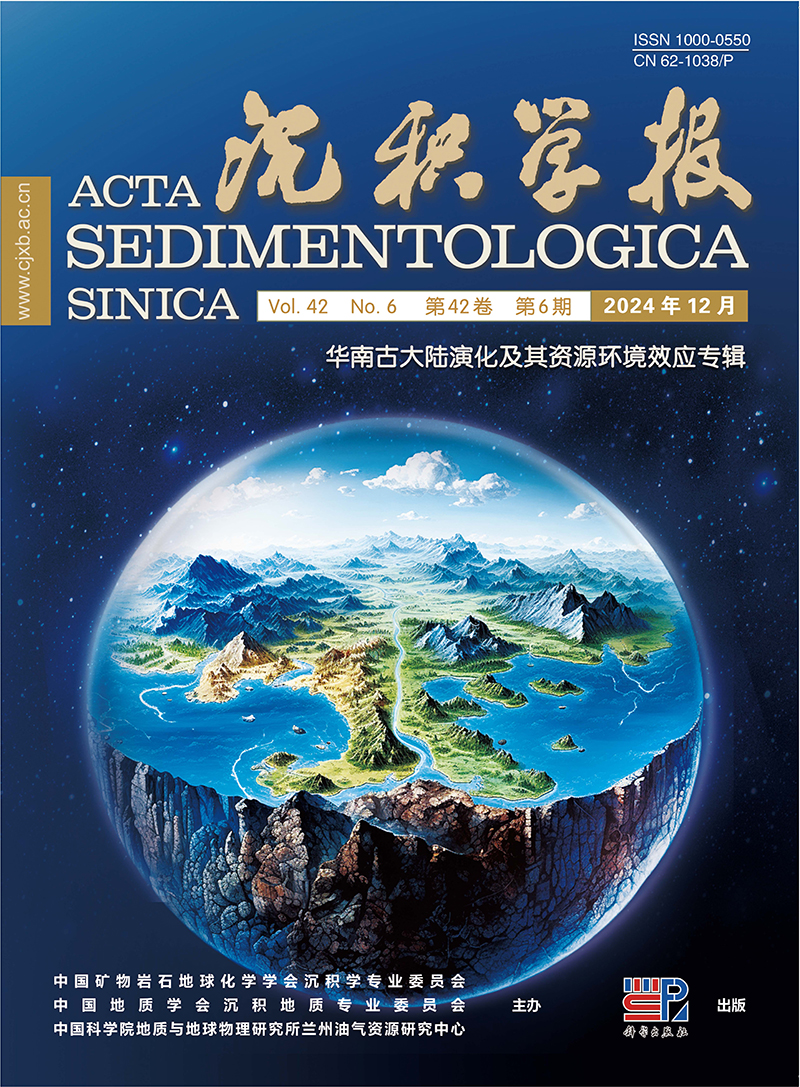


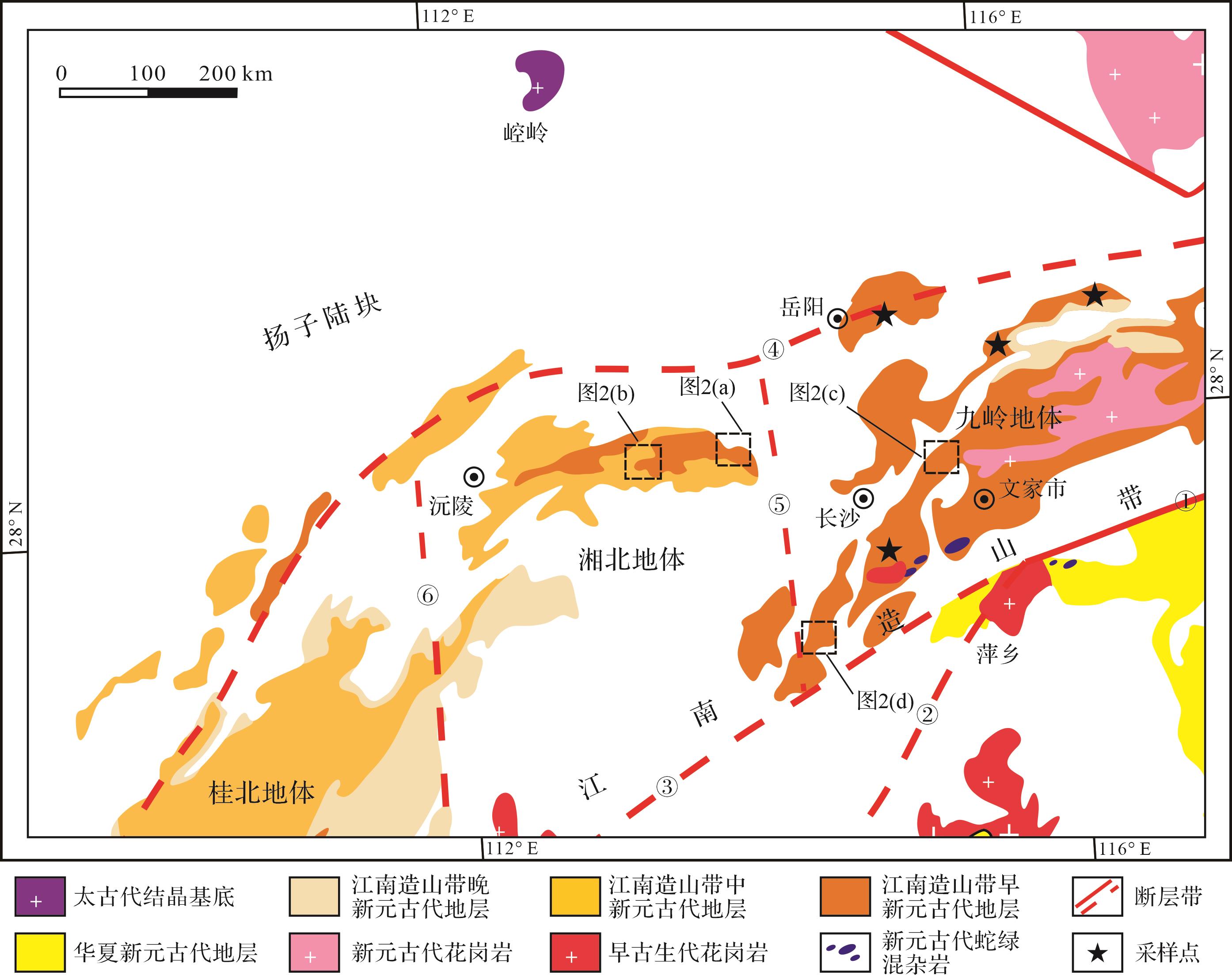








 DownLoad:
DownLoad:

